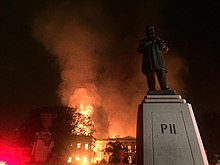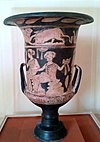Museu Nacional da Universidade Federal do Rio de Janeiro
The Museu Nacional da Universidade Federal do Rio de Janeiro (MN), or Museu Nacional UFRJ ( German National Museum of the Federal University of Rio de Janeiro ) is the oldest scientific institution in Brazil and the largest natural and ethnological museum in Latin America with an important paleontological and anthropological museum Collection, which also includes America's most famous skeletal fragments, the so-called "Luzia" , as well as some of the oldest dinosaur fossils in Latin America. a. the only known skeleton of the Maxakalisaurus . The exhibits also include a collection of meteorites, including the Bendegó meteorite .
history
founding
The museum was opened on June 6, 1818 by decree by the Portuguese King John VI. founded as Museu Real . It was intended to promote science and research in Brazil. Originally the museum housed a botanical collection and preserved animals, especially birds, which made the old building, which was still on Campo de Santana in downtown Rio de Janeiro , known as the “bird house” ( Casa dos Pássaros ). The Franciscan and natural scientist Frei José da Costa Azevedo was appointed the first director .
In 1824 the name was changed to Museu Imperial e Nacional . Emperor Pedro I had acquired a number of Egyptian works of art and mummies for the museum, and Empress Teresa Cristina a collection of Greek, Etruscan and Roman works of art. The exhibits also include the largest meteorite that has been found in Latin America to date, weighing more than five tons .
Relocation to the Palácio de São Cristóvão
The museum has been called Museu Nacional since the founding of the republic and has been in the Palácio de São Cristóvão , a former seat of the royal Portuguese and from 1822 to 1889 of the imperial Brazilian family and 1890/1891 of the first constituent assembly of the republic, in today's city park Quinta da Boa Vista .
20th and 21st centuries
In May 1938 the museum was registered under the number 101 in the list of monuments of the Serviço do Patrimônio Histórico e Artístico Nacional and today's IPHAN . Since 1946, the museum has been one of seven museums associated with the Universidade Federal do Rio de Janeiro .
Since February 2018, the museum director has been the paleontologist Alexander Kellner for the term until 2021 , who succeeded his predecessor, the archaeologist and biological anthropologist Cláudia Rodrigues Ferreira de Carvalho .
Fire on September 2, 2018
In the night of September 2nd to 3rd, 2018, the museum building was destroyed by a major fire; According to initial findings, a large part of the around 20 million exhibits are likely to be lost or badly damaged.
Museum directors
Museum organization
The main departments of the museum are divided into:
- the Departamento de Antropologia (Department of Anthropology ) with the sections for biological anthropology, social anthropology, archeology, ethnology and ethnography and the section linguistics as well as around 130,000 anthropological museum objects;
- the Departamento de Botânica (Department of Botany ) with the herbarium founded in 1831 by the German botanist Ludwig Riedel (1790–1861) with 550,000 objects and a botanical garden ( Horto Botânico ) with an area of 40,748.50 m², of which around 20,000 m² are green with about 330 examples from the Brazilian ecosystems and exotic plants;
- the Departamento de Entomologia (Department of Entomology ) with about 5 million items;
- the Departamento de Geologia e Paleontologia (DGP) (Department of Geology and Paleontology), founded in 1842 , which had 26,160 fossil objects in its collection as of 2017;
- the Departamento de Invertebrados (department for invertebrates ) with a collection together with that of the molluscs of around 45,000 collection objects;
- the Departamento de Vertebrados (Department of vertebrates );
- Postgraduate programs.
Exhibits
The best-known exhibits included the skeletal parts of Luzia , dated to an age of around 11,000 years, making it one of the oldest human remains to be found on Brazilian soil to date. On the other hand, the remains of the Maxakalisaurus discovered in Brazil in 1998 were on view in the museum . The museum contained a collection of hundreds of ancient Egyptian art objects - the largest such collection in Latin America. The museum housed several frescoes from Pompeii and numerous artifacts from pre-colonial indigenous cultures from Central and South America.
Sarcophagus of Sha-Amand-en-su (approx. 750 BC) from the ancient Egyptian Third Intermediate Period
Chalice of the red-figure vase painting from Campania (approx. 4th century BC)
Ceramic vase of the Inca civilization (approx. 15th century)
Ceramic figure of the Wari culture from Peru (approx. 500–1200)
Mask of the Ticuna from the ethnological collection depicting a monkey (17th or 18th century)
A collection of cultural objects (ceramics, tools, weapons, jewelry) by the Austrian missionaries Karl and Anton Lukesch was donated by the State of Styria to representatives of Brazil in March 2020 . The National Museum received some new exhibits as a contribution to compensate for fire losses. The donation was subject to the condition that the original owners on the Rio Xingu would be informed of the donation.
Publications
In addition to a series of scientific books, supplemented by a series of books in digital form since 2013, the museum publishes periodically
- Archivos do Museu Nacional , Volume 1, 1876 f., ISSN 0365-4508
- Boletim do Museu Nacional in four thematic sub-series for anthropology, botany, geology and zoology
literature
- Débora de Oliveira Pires (Ed.): 200 anos do Museu Nacional. Associação Amigos do Museu Nacional, Rio de Janeiro 2017, ISBN 978-85-89128-10-0 ( online ).
Web links
- Official website of the museum (Portuguese)
Individual evidence
- ^ Daniel Victor: What Artifacts Were in the National Museum of Brazil? In: The New York Times . September 3, 2018 ( nytimes.com [accessed September 3, 2018]).
- ↑ Lista dos Bens Tombados e Processos em Andamento (1938 - 2018). Retrieved September 2, 2018 (Brazilian Portuguese).
- ↑ Alexander Kellner toma posse como diretor do Museu Nacional. In: Website of the Conselho Nacional das Fundações Estaduais de Amparo à Pesquisa (Confap) of February 20, 2018. Accessed September 4, 2018 (Brazilian Portuguese).
- ↑ Brazil's National Museum burned down. In: tagesschau.de. September 3, 2018, accessed September 3, 2018 .
- ↑ Lívia Torres, Matheus Rodrigues, Nathalia Toledo, Ricardo Abreu, Lilia Teles: Incêndio de grandes proporções destrói o Museu Nacional, na Quinta da Boa Vista. In: G1. September 2, 2018, Retrieved September 3, 2018 (Brazilian Portuguese).
- ↑ Débora de Oliveira Pires (ed.), Mercia Ribeiro Anselmo (ed.): 200 anos do Museu Nacional . Associação Amigos do Museu Nacional, Rio de Janeiro 2017. online at www.museunacional.ufrj.br (Portuguese)
- ↑ Egito Antiguo. National Museum of Brazil, accessed September 4, 2018 (Portuguese).
- ↑ Kleine Zeitung, March 9, 2020, Styria: Indigenous art returns home to Brazil
- ↑ Out and about in Deutschlandsberg: Original objects from the Lukesch Collection go to Rio. In: Weststeirische Rundschau . No. 12, Volume 2020 (March 20, 2020) 93rd Volume. ZDB -ID 2303595-X . Simadruck Aigner u. Weisi, Deutschlandsberg 2020, p. 3.
- ↑ digitized tape 1-68, 1876 to 2010 with index .
- ↑ See also: ZDB -ID 421773-1
Coordinates: 22 ° 54 ′ 21 ″ S , 43 ° 13 ′ 34 ″ W.







